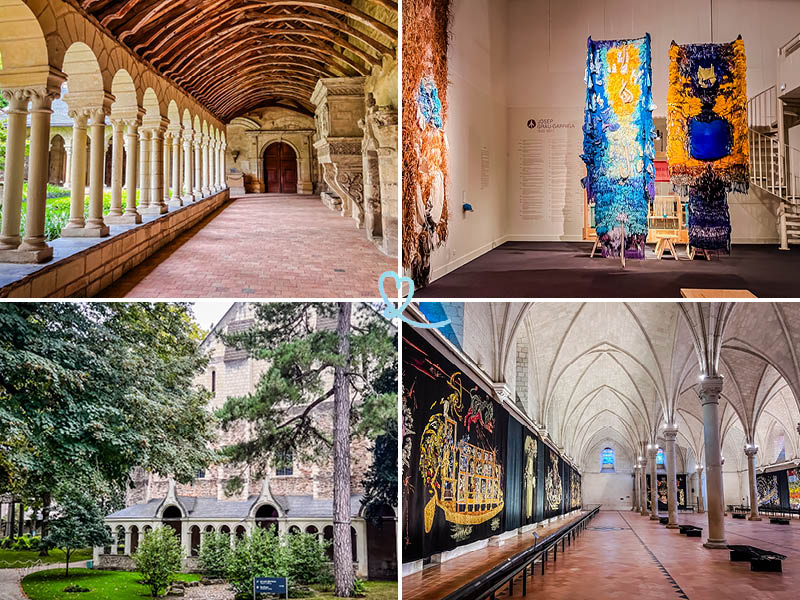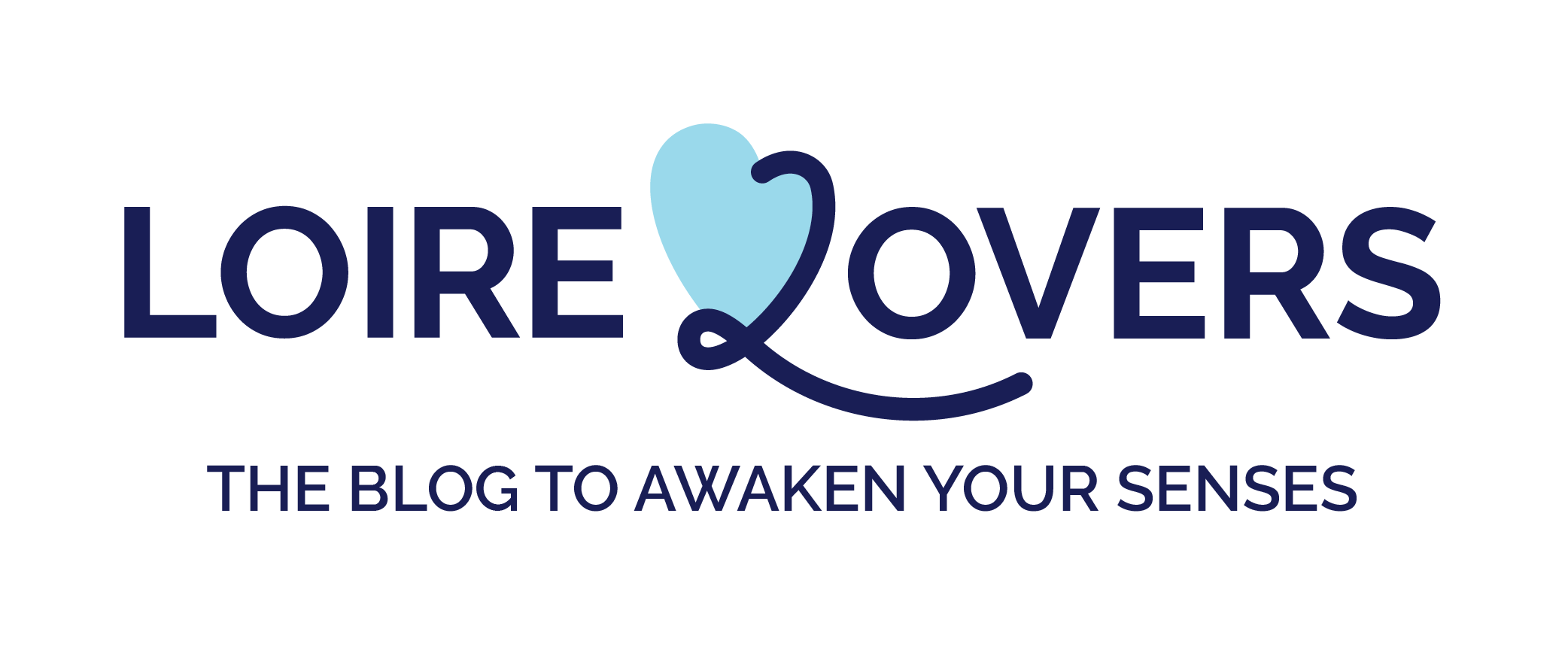Out and about in Angers? Take the time to visit the Muse Jean Lurçat and of the Contemporary Tapestry!
A cultural landmark in the city of Angers, the museum is a unique place combining the splendor of the past with the boldness of the present. This architectural jewel from the Middle Ages is home to masterpieces of contemporary tapestry, which we're sure you'll enjoy reading about in this article.
Discover our useful tips in pictures to help you prepare for your visit and have a wonderful time!

This guide is completely independent, based on our experiences. We visited the region anonymously, making our own choices and paying our bills in full.
Why visit the Jean Lurçat Museum?
Is the museum worth it? Our opinion:
Yes, absolutely! Unfairly little known, the Jean Lurçat Museum is well worth a visit. We fell in love with this unique site in the heart of downtown Angers. An alliance between the past and contemporary art, it exhibits major works of tapestry from the 20th and 21st centuries in a venue steeped in history. Nestled in its green setting, the museum is a veritable jewel of medieval architecture (12th century).
It's one of the best attractions in Angers and one of our favorite museums.

Why is the Jean Lurçat Museum famous?
The eponymous museum owes its fame to the artist Jean Lurçat (1892-1966). Also a painter and ceramist, he is renowned for his creativity in the field of international tapestry art. The museum pays tribute to the man and his works, which we loved discovering!
One of them is justly famous: the tapestry Le Chant du Monde (1957-1965). You'll be captivated by this masterpiece, which echoes the famous Apocalypse Tapestry, the largest medieval tapestry in the world, now housed in the Château d'Angers.
Finally, the Lurçat Museum is renowned for its architecture. This former medieval hospital has been converted into a museum and is an exceptional venue for exhibitions. Angevin Gothic style combined with contemporary tapestry art make this a superb blend of history and modernity.

Our favorite moments
The Jean Lurçat Museum is home to many beautiful things. During our visit, we particularly appreciated:
- the splendid Chant du Monde tapestry: at 80m long and 4.4m high, it's the largest contemporary tapestry ensemble! We marveled at this masterpiece that reinterprets the Apocalypse with a modern twist.
- the vast Salle des malades: located at the heart of a remarkable 12th-century architectural ensemble, this magnificently proportioned room is a superb illustration of Anjou Gothic architecture.
- The softness of the garden: we enjoyed strolling through this garden with its tall trees that surround the buildings with shade and greenery.

WHERE TO STAY IN Angers
Our favorites: neighborhoods and hotels
Downtown, to enjoy the city, its restaurants and beautiful architecture.
Hôtel L'Oisellerie - see photos and availability
Hotel 21, Foch - prices, pictures and availability
In the surrounding countryside, for greater peace and quiet
Hotel Château des Forges - see photos and availability

History in brief
The Jean Lurçat Museum is a site with a rich and complex history. This astonishing place harmoniously combines its medieval past with contemporary creation.
- Middle Ages: Around 1175, the Hôpital Saint-Jean was founded by Étienne de Marçay, seneschal (king's officer) to Henry Plantagenet, King of England and Count of Anjou, to meet the growing needs of the inhabitants of Angers. The large ward, which we visited, was built around 1200. Inspired by regional building practices, the architecture of the buildings is typical of Anjou Gothic. Shale stone, tuffeau and particularly rounded vaults characterize this 12th-century Anjou style. Taken in hand in 1203 by monks, the hospital opened its doors to the sick and needy for over 8 centuries.

- 17th century: In 1639, the hospital was taken over by nuns, the Daughters of Charity.
- Contemporary times: In 1849, construction began on a new hospital, now the Centre Hospitalier Universitaire (CHU). Patients from the Hôpital Saint-Jean were transferred there in 1865. The ward was then converted into a museum of antiquities. In 1968, the collections were replaced by Jean Lurçat's Chant du Monde tapestries, which we were lucky enough to admire! In 1986, the site was expanded. The hospital's former bathrooms and nuns' quarters, converted into an orphanage in the 19th century, were refurbished to become the Museum Jean Lurçat and of the Contemporary Tapestry we know today.

Access: Museum Jean Lurçat and of the Contemporary Tapestry, Angers
Where is the museum?
- In downtown Angers
- 4 boulevard Arago
- a stone's throw from the Maine river
- 25min walk from Château d'Angers and 20min from Cathédrale Saint-Maurice
OUR TIPS FOR RENTING A CAR IN Loire
- Compare prices on our preferred platform: DiscoverCars - one of the best rated sites.
- Choose a fairly compact car (many villages have narrowed the road).
- Think aboutfull insurance (parking in big cities is really tight).
- There is a lot of demand, book it early.

How to get there?
The museum is served by bus line 2 (La Rochefoucauld stop) and tramway A (CHU-Hôpital stop). Do you have the time and inclination to walk? You can walk to the Lurçat Museum and enjoy the banks of the Maine. The train station is a 25-minute walk away.
To plan your journey, we suggest you visit the official Angers public transport website here.

Parking
The Jean Lurçat museum has a large parking lot. Located across the boulevard Arago from the river, it's free and easy to get to. Are you on a bike? The city of Angers has thought of everything. There are 2 bicycle parking spaces opposite the museum entrance. See our article La Loire à vélo for more destinations to visit by bike!
DISCOVER Angers
- Things to do in Angers
- Where to sleep in Angers: best hotels
- Where to eat in Angers: best restaurants
- Rent a car in Angers
- Visit the Château d'Angers
- Visit the Museum of Fine Arts in Angers - coming soon
- Château de Brissac
- Terra Botanica
- Best castles around Angers
- Most beautiful villages around Angers

Useful tips: duration, schedules, eating...
Best time to visit
The Jean Lurçat museum is generally busiest at weekends. During the summer and school vacations, there are also more visitors. However, this is still acceptable. We advise you to plan your visit in the morning. You can enjoy the exhibitions at your own pace and in peace and quiet.
Length of visit and main difficulties
You'll need between 1 and 2 hours to explore the exhibits, the various buildings and the garden.
The site is accessible to people with reduced mobility and disabilities. It offers a wide range of facilities:
- a drop-off point opposite the gate at the corner of rue Auguste Michel and boulevard Arago
- access to the former Saint-Jean hospital is through a door on the left of the building
- collections of contemporary tapestries in the former orphanage, accessible via an inclined ramp
- adapted toilets
- loan of folding chairs
- adapted guided tours

Advice on how to visit
The Jean Lurçat museum comprises several sites. They can be visited in any order. We decided to start our exploration at the old orphanage. This building houses the museum's permanent collections and temporary exhibitions . You'll discover works that retrace Jean Lurçat's career. The museum also showcases tailoring methods in a fun, interactive way. We then went on to admire other, more abstract, 20th-century tapestries, in particular the by Polish artist Thomas Gleb and Spanish artist Josep Grau-Garriga.

The tour continues in the old Saint-Jean hospital. You'll be captivated by the medieval architecture of the grand ward, typical of the Gothic style of Anjou. Le Chant du Monde stretches for dozens of meters, revealing the beauty and horror of the 20th century. We were transported into the poetic and tragic universe of a contemporary Apocalypse. A former apothecary's shop tucked away in the market hall also caught our eye. At the far end of the huge hall, we slipped through a small door into the peaceful cloister. The beautiful vaulted walkways supported by stone columns open onto a garden and invite you to take a stroll. We ended our visit with a stroll in the park under the shade of the trees.

A LITTLE MORE patience
All the photos, maps, information, good addresses to make your stay in the Loire Valley a success, will soon be gathered in a single ebook!
If you wish to be informed of the publication of our guide on the Loire, register:

Visiting with children
The museum Jean Lurçat and of the Contemporary Tapestry offers a wide range of activities for children. Fun and interactive, the tour of the exhibition spaces allows curious youngsters to discover tapestry. Puzzle boxes are placed at the foot of works to be reproduced. Furniture at children's height and videos explaining spinning techniques are scattered around the rooms.

Throughout the visit, tactile experiences are offered for young and old alike. Eternal children, we too let ourselves be seduced by these explorations and even wove a few rows on one of the looms available to the public!

On certain days, the Jean Lurçat Museum also offers tours and discovery workshops specially designed for young visitors. Invited to become sorcerer's apprentices or to embark on a weaving mission, children plunge into the world of textile art. Are you planning a family visit to the museum and would like to plan an activity for your children? We recommend you take a look at the program and book in advance here.

Schedules and rates
The Musée Jean Lurçat et de la Tapisserie Contemporaine is:
- open Tuesday to Sunday, 10 a.m. to 6 p.m.
- closed Mondays, January 1, May 1, November 1 and 11, December 25
And here are the museum prices:
- Full price: €6
- Half-price admission: €3 (jobseekers, tourism professionals...)
- Free admission for under-26s and every day between 5pm and 6pm (the same for all Angers museums!).
To find out more about admission conditions and the list of free and half-price beneficiaries, visit the official Angers museums website here.
City Pass holders can also enter the museum on presentation of their pass. This paying card gives access to over 20 tourist sites in Angers and the surrounding area. Click here to find out more. And if you feel like planning a visit to the Galerie David d'Angers, take a look at our dedicated article (coming soon)!
Guided tours
The Musée Jean Lurçat refuses to organize guided tours, preferring to refer to them as " Commented Tours". These 1? hour themed strolls follow the visitor's gaze and give pride of place to discussions around selected works.
These courses are scheduled on specific dates each year. To make sure you don't miss out, we recommend that you consult the timetables or rates and book here.

Catering
There are no food outlets on site, but downtown Angers is teeming with restaurants offering tempting menus!
- A 15-minute walk from the museum, Restaurant La Cour offers local cuisine in a friendly, relaxed atmosphere.
- Cross the Maine and discover Milk, Thyme, Salt. With a Michelin star, this restaurant will delight your taste buds with its exquisite dishes.
- You'll also be charmed by the authentic dishes of the bistronomic restaurant Le Bistrot des Ducs. Finely prepared seasonal products on the menu!
Do you love cooking? Take a look at our article on the city's best restaurants and let our mouth-watering selection be your guide.

A unique exhibition space
The medieval hospital and its shady garden
An exceptional 12th-century architectural ensemble, the Jean Lurçat Museum stands out for the splendor of its walls. This former medieval hospital has been transformed into a showcase for contemporary art. We were particularly impressed by the former salle des malades, one of the most beautiful rooms in the museum. A masterpiece of Anjou Gothic, it is 60m long and 22.50m wide. The strongly cambered vaults draw the eye, which is then seduced by the plant motifs and volutes adorning the columns of the three naves. Like us, you'll be swept away by the majesty of the place!

A curious apothecary , tucked away in one corner of the vast hall, bears witness to the hospital's former function. Installed in 1962, it was placed in the sick room of the city's antiquities museum. Dating from the 17th century, it features 19th-century earthenware and glass pots of various sizes and functions. A magnificent pewter vase sits at the center of the cabinet. We were touched by this vestige of the complex's former activity.

Contrasting with the finesse of its interiors, the robustness of the hospital's facades is softened by the tranquility of the garden. Remodeled several times over the centuries, the small park surrounds the museum with greenery. The tall trees caress the old stones and give the place an air of mystery. You'll love strolling under their peaceful shade.

The cloister and chapel
A cloister and chapel adjoin the patients' ward. Transported back in time, we walked in the footsteps of the monks in the shadow of the galleries. Round-arched arcades and colonnettes divide into 2 magnificent aisles.

Walking through one of them, we admired an imposing stone fireplace with geometric motifs. We also discovered the tomb of Elisabeth de Soland (daughter of an Angers commander during the French Revolution), created by the father of the famous 19th-century sculptor David d'Angers. The chapel' s finely carved wooden door is also remarkable. This 16th-century storefront finely depicts Christ and several saints.

The cloister frames a small courtyard. We strolled through this pretty walled garden. Restored, it can now be seen in its medieval version. The squares of "simples", the name given to medicinal plants in the Middle Ages, recreate the former utilitarian function of the enclosure. In the center, a 15th-century well accentuates the poetry of this charming setting.

The old orphanage reinvented
A second exhibition site, this former municipal orphanage was added to the museum in 1986. Formerly the home of the Sisters of Charity who ran the hospital, the building was completely restored in the 1980s. He transformed the former Jean Lurçat museum into the "Musée Jean Lurçat et de la Tapisserie Contemporaine". We enjoyed visiting this more modern space!

The building houses a collection of works that contextualize textile and tapestry art in history. Carried along by the thread of the hangings, we followed the evolution of tapestry from the 1930s to the most contemporary approaches. Recent donations have enriched the museum's permanent collection, enabling the public to discover important figures in the art of tapestry, such as the Polish artist Thomas Gleb and the Catalan Josep Grau-Garriga. A dedicated room, the news gallery, showcases the latest acquisitions. The former orphanage also hosts temporary exhibitions devoted to contemporary tapestry at its most creative, and to the diversity of textile expression. It showcases the great names of post-war French tapestry, artists of the Nouvelle Tapisserie of the 1960s and 70s, as well as designers of recent decades.

The art of tapestry
The legacy of Jean Lurçat
Jean Lurçat (1892-1966) is the museum's leading figure. This great artist left his mark not only on the region, but also on the world of 20th-century tapestry.
During our visit, we learned a great deal about his artistic career. In 1937, Lurçat discovered the extraordinaryApocalypse Tapestry at the Château d'Angers and realized that tapestry was an art form with a singular language. After the Second World War, he tried his hand at tapestry in Aubusson, a town historically famous for its weaving workshops, and attempted to modernize the art. He developed new techniques such as numbered cardboard, counted stitch and reduced color ranges. Establishing himself as the figurehead of the French tapestry Renaissance, he devoted the second half of his career to promoting and publicizing this artistic field.

The museum has been home to works by Jean Lurçat since 1968. A year after the artist's death, the town of Angers acquired the famous Le Chant du Monde tapestry in 1967. We'll tell you all about it right after! In 1988, a major donation from Simone Lurçat, the artist's last wife, added to the museum's collection. This collection, the Lurçat collection, has since been supplemented by a policy of regular purchases. So we were able to admire other works by Jean Lurçat. Tapestries , paintings and ceramics are presented chronologically, enabling visitors to follow the development of his artistic approach and to learn about the major art movements of the first half of the 20th century.

The masterpiece Le Chant du Monde
An immense hanging measuring over 80m, Le Chant du Monde is Jean Lurçat's masterpiece. This project was launched in 1957 in the town of Aubusson at three workshops (Tabard, Picaud and Goubely). The task was so titanic that it took almost 9 years to weave the 10 tapestries.

The work was conceived by Jean Lurçat as a contemporary version of the Tenture de l'Apocalypse, the famous 100m-long tapestry from the Middle Ages that we were lucky enough to see in the Château d'Angers. The location of Le Chant du Monde, just a few hundred meters from the château, is no coincidence. It's a tribute to the will of the man who wanted his work to be close to the work that inspired it. We found that the vast salle des malades, a medieval architectural showcase, wonderfully reveals the bold beauty of the hanging.

Powerful and colorful, the work transports us into a poetic and symbolic universe. The artist delivers a personal message of peace and hope. Jean Lurçat plays with contrasts through colors and scenes of beauty and terror. In his own words, life is shown as "sweet and salty, bitter and sweet, convulsive and serene". We were shaken by La Grande Menace, which materializes the spectre of the atomic bomb, but also by L'Eau et le Feu, a veritable ode to creation.

Other stunning works
The Museum Jean Lurçat features other remarkable works, representative of late 20th-century tapestry. The work of Polish-born painter Thomas Gleb is featured. After a decisive meeting with weaver Pierre Daquin, the painter was propelled into the Nouvelle Tapisserie movement and became one of its leading figures. In the post-war period, this artistic movement renewed tapestry in terms of materials and techniques, as well as themes. The museum presents a selection of tapestries by Thomas Gleb, whose metaphysical dimension is embodied in "white on white".

We also appreciated the work of Josep Grau Garriga. This Catalan-born artist settled in Anjou in the 1990s. These works, also inspired by the proximity of rivers and the play of light on water, reveal his vision of rural life. The mix of vivid and natural colors and the designer's emotional inspirations moved us.

At the Museum Jean Lurçat, the song of the world is embodied not only in tapestry, but also in music! We learned that the museum hosts other types of works , including musical events. It also features a number of festivals, such as Food'Angers, where you can discover Anjou through gourmet delights. Find out more about the event here. A mini-textile competition is also organized every three years. Check out the museum's eclectic program here!
Subscribe to our Newsletter
- Get away from it all with Region Lovers' beautiful destinations!
- Once a month
- Advertising-free
Frequently asked questions
What tourist attractions are nearby?
Located in the heart of Anjou and the city of Angers, the Museum Jean Lurçat is close to many tourist attractions:
- Château d'Angers: the city's landmark, this superb medieval fortress features the famous Apocalypse Tapestry, over 100m long! We were captivated. See our dedicated article.
- Cathédrale Saint-Maurice: perched on a hill, the cathedral is the cradle of Anjou's distinctive Gothic architecture! Read this article to find out more.
- La Maison d'Adam: in the heart of the city center, this 16th-century half-timbered house will transport you back in time to the history of Angers.
- Île Saint-Aubin: in the mood for nature? Visit Île Saint-Aubin to recharge your batteries and observe the protected species it shelters.

Can I see the Apocalypse Tapestry at the Museum Jean Lurçat?
The Museum Jean Lurçat is also the museum of contemporary tapestry. The Apocalypse Tapestry dates back to the Middle Ages. It is exhibited at the Château d'Angers in a gallery specially created for the purpose. But although the famous masterpiece is not on display at the Museum Lurçat, another major work is: Le Chant du Monde, a magnificent tapestry ensemble that echoes the medieval hanging!
What events take place at the Museum Jean Lurçat?
In addition to the temporary exhibitions the museum organizes throughout the year, other cultural events are added to the program. This exceptional space opens its doors to concerts and festivals, such as Food'Angers, which showcases Anjou's local produce and know-how.Here's an overview of the schedule of events.
PLAN YOUR TRIP IN
Loire Valley
The castles of the Loire Valley

Other places to explore







